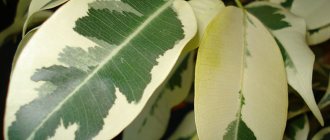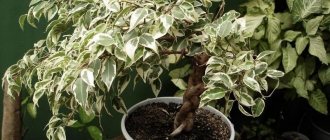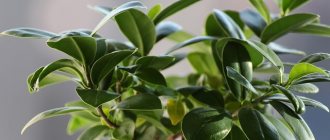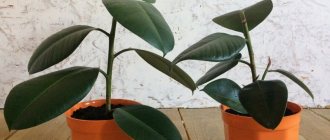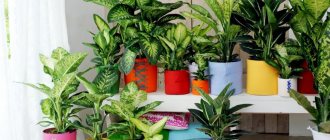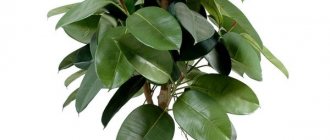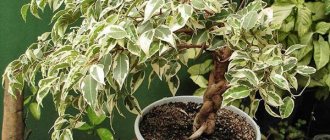Many home gardening enthusiasts prefer evergreens. One of these is Ficus Benjamin (Latin name Ficus benjamina), from the Mulberry family. It owes its name to the Spanish botanist Jackson Benjamin Daydon. The growth of a plant is influenced by both the variety and the conditions under which it is kept.
Artificially grown ficus does not have flowers, but is quite popular due to the beautiful varied color and shape of the leaves. Its various types decorate apartments, offices, shopping centers, airports, and train stations.
The shrub's natural habitat is the humid tropics; it grows in the wild of Southeast Asia, India, the Philippines, Australia and others. The height of some species can be 25 - 30 meters.
Ficus Benjamin, if certain care measures are taken, can please amateur flower growers for up to 15 years, sometimes longer.
The modern market offers a huge selection of ficuses, from a small bush to a tree reaching a height of 1.5 - 2 meters. Despite the fact that Ficus Benjamin is not a very demanding crop, it has its own growing characteristics.
Transplant procedure
Ficus benjamina cannot be replanted only at will. There must be a compelling reason from the following list to begin this process:
- The growing container has become too small.
- The root system enveloped the entire earthen ball.
- Replanting is required due to changing the soil or improving the drainage system.
- During reproduction.
As a rule, it is recommended to replant the plant annually. The spring period is chosen for this. And only specimens that have reached 3 or even 4 years of age can be replanted every 3 years. Do not forget to add fresh soil to the container with the plant from time to time.
The container for transplanting Ficus Benjamin should be chosen not too spacious and large. Choose a pot a couple of centimeters wider than the previous one. It is imperative to ensure good drainage.
The flower reacts negatively to alkaline soil or soil with high acidity.
You need to be extremely careful with the root system of the plant. She is very fragile. That is why the entire reproduction process will take place by transshipment along with an earthen lump. A couple of days after transplanting, you can water the plant.
If you purchased ficus benjamina from a specialty store, then do not rush to replant it. You need to wait for the adaptation period to complete, which lasts about a month.
The necessary conditions
Ficus is not a very capricious plant. For it, you should choose a sufficiently lit place, but the light should not be direct. Western and eastern windows are considered favorable for ficus. If there is a lack of light, the plant will have fewer leaves.
Ficus is a heat-loving plant . In the summer, when all the flowers are put on the balcony, it is left in the apartment. It does not tolerate drafts and strong winds. A comfortable temperature is considered to be from 15 to 20 degrees, and in summer – no more than 30.
General features of the plant
The genus belongs to the Tutov family. Most representatives are evergreen and only 10% lose their leaves. Domestic and wild species have a solid leaf structure. The stipules are usually large in size and fall off quickly.
Ficus is distinguished by inflorescences with a characteristic ball or pear shape. The buds are formed on the inner surface, and the flowers themselves are small in size and light in color. They can grow singly or form in groups.
Homeland, history and description of ficus species
About 800 species of the family can be found in the tropics. About 100 species grow in subtropical latitudes. Some heat-loving plants live in Mediterranean countries. Most of the species are distributed on the islands of the Pacific and Indian Oceans, in western Africa and Latin America.
The history of ficus trees is quite long - in our time you can admire the tombs of Ancient Egypt, which are made from the African species of this plant. Over many thousands of years, many plant forms have appeared, from giant to dwarf ones. Some ficus trees are considered sacred by Muslims: we are talking about the fig tree and the fig tree.
Ficus is often called the rubber tree. Everything is explained by the special composition of milk, which is found in the leaves and stem. The plant is used for industrial purposes, because its juice consists of 15% rubber. In the wild, many animals eat ficus leaves.
In Africa and Mexico, the leaves of large trees are used during construction to line roofs. In some countries, living bridges are made from ficus trees. To do this, they throw the bamboo over the ditch and wrap it with the aerial roots of the plant. For about 10 years, the vine grows around the supports. Such a structure can support the weight of 50 people who will simultaneously stand on the bridge.
Benjamin
The evergreen plant grows up to 10-20 meters in height. At home it grows as a bush and no higher than 3 meters. The crown has a regular shape and is gray-beige in color. It is so thick that the trunk is difficult to distinguish. An unusual tree shape can be created if the aerial roots of the plant are correctly connected.
Ficus benjamina
The leaves of Ficus Benjamin are oblong in shape, ranging from 5-20 cm in length and 2-5 cm in width. They can be either single-color or two-color, depending on the variety. Many beliefs are associated with this type of ficus. Some claim that it helps in conceiving children and for this purpose the plant is placed in the bedroom.
Rubber-bearing
The most popular type does not require special care. The trunk has a small number of branches and in an apartment can grow up to 2 meters in height. The leaves with a pointed end are elliptical in shape and have a glossy finish. Different varieties have different foliage colors.
Ficus bengal
The origin of the Bengal ficus leads us to the shores of Sri Lanka, India, Bangladesh. This is one of the representatives of the mulberry world, absolutely fantastic, from the point of view of an inhabitant of the northern hemisphere of the Earth, ficus banyan. Banyan refers to the unique life form of this plant. This amazing tree resembles a fairy-tale giant and, rather, looks like a dense forest consisting of many trunks.
How does this process happen?
The tree trunk is formed by shoots from which aerial roots emerge. The roots initially have a small thickness; as they develop, they begin to reach the ground, take root, and then they rapidly develop and increase in diameter to several meters. New trunks give rise to new shoots, and this process does not stop, repeating itself again and again. Over time, one tree gradually turns into a real fairy-tale forest, occupying an area of several hectares.
The most impressive tree of the family is considered to be the Great Banyan of the Indian Botanical Garden, numbering about three thousand trunks.
In the interior of a city apartment, this tree will look much more modest, but if you decide to keep such a ficus within your home walls, you need to create a number of conditions for it. And, if you are not embarrassed by the size of the Bengal ficus, and it can grow up to three meters high, then, following all the rules of care, you can relax under the crown of a wonderful tree and enjoy the fresh air.
It could be a completely miniature bonsai.
Is the plant suitable for bonsai formation?
To grow a bonsai from a ficus benjamina, you need to regularly trim its roots and crown, giving the branches the desired shape in accordance with one of the directions of this art. Having no experience in growing miniature trees, you should start with the tekkan style - the simplest, classic option.
To form a bonsai you need:
- plant the plant in a wide, flat pot filled with plenty of drainage;
- trim the root system twice a year - shorten the roots by 1/3 and remove the main stem, stimulating the development of thin rootlets;
- after complete rooting, pinch the top of the ficus - this promotes the growth of the crown and roots in breadth;
- shorten branches that have 8-10 leaves, leaving only 2-4.
Expert opinion Andrey Petrovich Mokhov Graduated from KubSAU, specialty: agronomy
For pruning, it is necessary to use sharp, disinfected tools, and treat the cut areas with garden pitch or crushed activated carbon.
You can give the desired shape to the trunk in 2 ways:
- tying the top or branch to the base, achieving a curved appearance;
- wrapping it with wire starting from the roots, giving any desired direction to both the trunk and branches.
When wrapping with wire, you can remove it after 2-3 months, without unraveling it, but cutting it off from the plant to avoid damage to it.
CORDILINA shrub Care, cuttings
Cordilina. Reproduction of cordyline
Cordilina.
Cordilina Care Tips
CORDILINA (Cordyline) Flowering and reproduction. False palm. Dominican Republic
CORDILINA - miniature DRACENA. Features of home care
Previous entry Abutilon (cableweed) Next entry Caring for pachira at home, description, signs and superstitions associated with the flower, types
Varieties and photos
Decorative varieties are bred from different species. Each has its own characteristics associated with the color and size of the foliage. Below are photos, names and descriptions of Ficus Benjamin varieties suitable for propagation and care at home:
Exotic
This compact variety was imported from Bali and Java. The leaf blades are dark, with a wavy edge. Neatness and decorativeness is ensured by the dense arrangement of foliage. Exotics are suitable for creating bonsai . For a florist, unpretentiousness and the ability to be placed on any windowsill, including on the north side, are important. Water rarely, after the soil mixture has dried thoroughly. The photo below shows Ficus Benjamin Exotica:
Daniel
The only difference from Exotica: large leaf plates with elongated tips are matte, rich green. Grows well in partial shade; the shape of the crown is determined by pruning. The height of the bush increases by 30 cm per year. This is a good option for those who want to have a tree up to the ceiling. In the photo below is the Ficus Benjamina Daniel variety:
Kinky
This is a variegated variety with a height of up to 40 cm. The leaf blades are dark, with a light green or yellow border along the edges, up to 4 cm long. It does not tolerate changes in location; in insufficient lighting, the leaves are monochromatic. Scientists have proven that Kinki absorbs benzoin and formaldehyde group substances from the air. Flower growers are attracted by the opportunity to create any crown shape by regular pruning.
Starlight
This variety is very impressive. The foliage is bright, with cream or white stripes, spots, or completely white. The leaf blades are slightly curved. Due to the small volume of chlorophyll, good lighting is required , but not direct sunlight. The temperature in the room is not lower than +20°C. It can be grown as a tree in a tub, a bush by the window, a bonsai, or a composition in a flower pot on the wall.
Baroque
This variety is given an unusual appearance by its leaves twisted crosswise into tubes. The front side of the plates is glossy, the color is rich green. Barok does not like coolness and movement. Several plants are planted in one container, since they practically do not branch. Growth is slow, which is why this variety is called pearl. Popular with collectors. You can see what the Ficus Benjamin Baroque variety looks like in the photo below:
Care
Since ficus is a tropical plant, it needs good lighting. However, direct scorching rays are not the best option, as is a heating device located near the ficus. If you see that the plant does not have enough natural light, take care of artificial lighting.
Professionals give some more important advice on caring for crops.
- The plant loves humidified air. It should be sprayed once a week with cool water if the microclimate is humid. If the air in the room is dry, you should spray more often.
- One watering per week is the maximum. Ficus trees do not tolerate overwatering.
- The correct approach to the soil is alternating fertile and sandy layers. Thanks to this, the plant will be healthy and long-lived. The soil for ficus should be moist and loose. But you can’t just loosen the soil: in order not to injure the delicate roots, alternating layers provide looseness and air flow.
- As the ficus grows, it should be replanted. If the plant is already mature, then it can live in one tub for years. The main thing is to feed it, periodically replacing the soil.
- The crown needs to be formed in the fall or spring, when the plant is either already going into hibernation or has not yet fully “woke up”. The shoots can be trimmed with pruning shears, but you should not simply break off the branches. Do not forget to treat the sections with a solution of potassium permanganate to prevent rotting.
If you create ideal conditions for a ficus, it can become a long-liver. But if you deny the plant water for a couple of weeks, let it become overgrown with dust, or pour coffee residue and other liquids unsuitable for the crop into the soil, the young plant will most likely die. But adult ficus trees have time to “build up armor”, so they are not so vulnerable.
To stimulate growth, you can use rose bush fertilizer. Nitrogenous mineral fertilizers are good. Ash and tree resin can be used as high-calorie fertilizer.
The plant does not tolerate drafts, so those who like frequent ventilation should think about another green “pet”. Even the most expensive ficus can quickly get sick if placed near a battery. If a putrid smell begins to come from the pot, mold can be diagnosed. In this case, the plant will be saved by replanting. And in order to avoid the invasion of pests that are not averse to feasting on the nutritious leaves of the ficus, the latter need to be wiped more often.
See more about ficuses in the video below.
Is it possible to keep it at home?
The attitude towards this plant of the Eastern and Slavic peoples differs significantly. If the former considered ficus a symbol of happiness in family life, then the latter called it a witchcraft tree that brings trouble. Let’s take a closer look at the attitude of various nationalities towards ficus:
- The Chinese perceived the ficus as a family plant, which was presented as a gift for weddings, birthdays, and also passed on to descendants. If you believe the beliefs, it helped cleanse the room of negative energy, gave people vigor and physical activity, which made it an ideal option for older people.
- The Thais also considered the ficus a sacred plant and were confident that it could ward off evil spirits. It is the Benjamin ficus that is the symbol tree of Bangkok, the capital of Thailand. And another variety of it became the personification of the island country of Barbados and was depicted on the state’s coat of arms.
- Slavic peoples attributed magical properties to the wax leaves of ficus Benjamin, endowing the plant with the ability to cause discord in families, provoke conflicts and lead to separation. Ficus Benjamin also acted as a muzhegon - it acquired such properties in the post-war period, when most of the families where the tree grew lost men who died at the front.
- The Bible speaks favorably . So one of its varieties served as the first robe for Eve and Adam, and the fruits of another type (namely figs) became their first food after the latter were expelled from Paradise.
Curly ficus *
#1 Dina
Not in the thunder of a cosmic catastrophe, not in the flames of atomic war, and not even in the grip of overpopulation, but in a well-fed, calm silence, the history of mankind ends. (A. and B. Strugatsky)
#6 Dina
Not in the thunder of a cosmic catastrophe, not in the flames of atomic war, and not even in the grip of overpopulation, but in a well-fed, calm silence, the history of mankind ends. (A. and B. Strugatsky)
#8 Dina
Not in the thunder of a cosmic catastrophe, not in the flames of atomic war, and not even in the grip of overpopulation, but in a well-fed, calm silence, the history of mankind ends. (A. and B. Strugatsky)
#11 Dina
Hm. Net is right. They answered me. They write that a constant temperature of 18-22 is desirable, high humidity, very good lighting, but no direct sun, abundant watering, but not allowing stagnation of water, i.e., good drainage and the pot should also not float in water in the pan. It is better to feed with natural compost (which they sell in bottles, but I think I’ve seen it here too). This Baroque's leaves straighten when the air is constantly too dry, due to improper watering and improper feeding.
Hmmm. It seems that the beauty of my new resident requires great sacrifice. :- ::)
Not in the thunder of a cosmic catastrophe, not in the flames of atomic war, and not even in the grip of overpopulation, but in a well-fed, calm silence, the history of mankind ends. (A. and B. Strugatsky)
#14 Natali
Hmmm. This is either an answer: humidity (the azalea is nearby and everything is fine with it), watering (I am absolutely not inclined to flood my plants, rather the opposite :P), feeding (and without organic matter it will absolutely not curl?
Methods for propagating Ficus Benjamin
The choice of propagation method is represented by cuttings, sowing seeds and air layering. Seeds are sown in early spring, covering the container with a bag and placing it in a warm, bright place. They germinate within a month, and, as a rule, after the appearance of the second true leaf, the young sprouts are planted in individual pots.
Reproduction using layering is used for difficult to grow varieties . You need to select a branch of small thickness and cut the bark on it with a ring, wrap it in damp moss and wrap it in polyethylene. After some time, roots will appear, and the cuttings are cut off for planting in the ground under the bag.
The common method of propagation is that a cutting of 15 to 25 cm is cut from the plant. It must be placed in warm water so that the milky juice flows out, and then the water must be replaced with clean water at room temperature. A piece of charcoal thrown into the water will prevent the future ficus from rotting. As soon as the roots appear, the cutting is transplanted into the ground under a plastic cap, which must be gradually removed to adapt the plant to the air environment of the room.
Cuttings are sensitive to dry air, which is why a polyethylene cap is used
Reproduction: how your Benjamin can bloom
Ficus plants are flowering plants, but do not bloom indoors due to the lack of natural pollination. Small insects pollinate the inflorescences through small holes located in the upper part of the future flower.
Female and male flowers are negligible and do not represent any aesthetic value, but are only suitable for reproduction. At home, ficus can reproduce only vegetatively - by cuttings.
In order for an indoor ficus to feel at home, it needs to create the appropriate conditions. In return, it will become a good friend to its owner, ennoble and cleanse the space, because it is not for nothing that the plant is sacred in many countries of the world.
Indoor plants decorate homes and make the environment more comfortable and welcoming. Many of them are so familiar that people have stopped thinking about their true origin. The real homeland of the popular indoor plant is tropical latitudes; almost 2000 species of ficus grow in forests and only 20 of them can decorate a windowsill. Each domestic type of ficus has its own differences.
Trimming
Pruning ficus is a necessary procedure in indoor growing conditions, because this plant grows exclusively upward.
Ficus trees can be given almost any shape, the main thing is to know the basic rules of pruning :
- the event is carried out only in the spring, before active growth begins;
- not all types of ficus produce a fork after pruning the central shoot;
- the cut is made horizontally above the internode bud of a young plant and obliquely if the shoot has already hardened;
- When pruned, tall stumps not only look unsightly, but can also become a haven for fungal infections;
- Sections after trimming must be processed.
As for sanitary pruning, weak and dry shoots can be removed year-round.
Often, for very mature plants, rejuvenating pruning is carried out “under the stump”.
Ficus pruning to rejuvenate the plant
Below is a video with a detailed description of ficus pruning:
Origin of individual varieties of ficus
As mentioned earlier, indoor crop lovers prefer to grow about 2 dozen varieties at home. The rubber-bearing type of flower is recognized as one of the most popular. It grows and develops well, does not require complex care, and has stable immunity to most diseases. It easily tolerates pruning and recovers quickly. This tree-like flower grows up to 2 meters, has dark green oval-shaped foliage up to 35 cm in size. The culture comes from hot countries - Nepal, Burma, West Africa, the Himalayas.
The variety has a variety distinguished by beautiful variegated leaves. Green-leaved varieties are less demanding on growing conditions. The variegated varieties include the rubber-bearing variety Robusta and Black Prince with leaves of the same color. Variegata has green leaves and cream edges, while Doecheri has variegated foliage with a red vein and pink spots on the surface.
What benefits does the plant provide?
Many may think that since the leaves are toxic, they secrete juice that causes allergies, which means there can be nothing good in the plant. This is wrong. Ficus is in great demand in folk medicine. In some countries (in the homeland of the flower), a large number of different medicinal tinctures are made from it. Moreover, the most valuable thing is that which is poisonous - ficus juice.
The flower allows you to cope
- vascular diseases;
- intestinal disorders;
- lung ailments;
- warts, calluses and wen;
- hemorrhoids.
Ficus is also in great demand in industrial sectors.
It is made from:
- fructose;
- tinctures;
- rubber;
- construction material
- medicines;
- rough cloth
- glucose;
- animal feed.
Kinds
Experts have bred a great variety of different types of Ficus Benjamin. The differences between them usually lie in the color, shape and size of the leaves.
Here are some of these varieties:
Barok is unpretentious, very similar to a miniature tree and has many subspecies with leaves of different shapes and colors.
Baroque
Anastasia - distinguished by an original pattern of leaves, it is very catchy and patterned.
Anastasia
Starlight - its feature is variegated leaves with white or cream spots on a green background.
Starlight
Golden King - this plant fully lives up to its name; it is the real king of ficus trees. It grows well, allows the formation of beautiful tall trees, and has a noble color of leaves with a golden edge.
Ficus Golden King
Variegated - this handsome guy really doesn’t like to change his surroundings. When purchasing it, find a permanent place for the plant to live.
Variegated
Daniel is a bright, cheerful green representative of the Benjamin ficus. Not as demanding on conditions as its variegated counterparts.
Daniel
Benjamin Mix is a magnificent representative of the genus, which can have leaves of a wide variety of colors - from plain to variegated. Whimsical and requires a lot of attention.
Ficus benjamina Mix
Kinky - easily tolerates haircuts and allows you to form any crown. Also, it is from Kinki that graceful trees with several trunks are “weaved”.
Kinky
Natasha is a dwarf variety of Benjamin with a compact, beautiful crown and variegated oval leaves.
Ficus Natasha
Where does Ficus Benjamin come from and where does it grow in nature?
The homeland of this plant is the tropical forest of Asia. Nowadays it can be found in India, China, and Australia. It also grows on the Hawaiian and Philippine islands. Ficus benjamina loves constant humidity and high air temperatures. Many people know that the inhabitants of the country of Thailand chose it as a symbol of their capital - Bangkok.
Growing problems
The lower foliage of tree-like species of domestic ficus may fall off from time to time due to natural, or physiological, reasons. Stunting of growth, as well as active loss of green mass, most often results from improper care of the plant.
Stopping growth
The main reasons may lie in a change in conditions of detention. In addition, the plant may stop growing when exposed to drafts, as well as as a result of temperature changes or changes in lighting. Very often, slow growth is caused by a lack of nutrients.
Diseases
Very often, as a result of waterlogging or other improper care, the plant is affected by fungal diseases or root rot. Rotting of the root system is caused by excessive soil moisture. An overabundance of fertilizers also causes the same effect.
Pests
The most common insect pests of ficus are spider mites, mealybugs, thrips, scale insects or false scale insects. Regular examinations allow plant parasites to be detected in a timely manner and corrective measures taken.
Diseases and pests
Just like any other plant, ficus benjamina can get sick and suffer from insects. The main sign of any deviation is a change in the condition of the foliage.
The tips of the leaves dry out. Most often, this sign indicates that the humidity in the room is too low or the temperature is below +15°C. It happens that the tips of the foliage dry out after an incorrect replanting (shaking the roots off the ground). In such a situation, weekly watering and spraying with Zircon helps. Another reason is to use soil from a greenhouse or street. The foliage problem can be caused by a nematode carried with the soil. The tips of the leaves also dry out if the bush has a too small pot.
Leaves are falling. Most often this happens if the ficus is placed near a heating device, the air in the room is too dry. It happens that such a problem arises due to drafts that occur during ventilation. The problem can be eliminated by changing the location, increasing the temperature, and streamlining the watering.
Why do the leaves turn yellow? Most often, the foliage turns yellow due to a lack of nutrients. The flower needs to be fed or replanted more often. Another common cause is overwatering. Less often, yellowness is caused by root rot, which is difficult to get rid of.
Why does it shed leaves and what to do? Ficus benjamina always sheds its leaves after being purchased and moved into a permanent container. It is considered natural for the lower leaves to fall off simultaneously with growth. Dropping leaves can also cause excess moisture or nutrients. A more serious reason is scale insect infestation. Simultaneously with the fall of leaves, growth and development slows down. Treatment with folk remedies or store-bought drugs is required.
Brown spots on leaves. Most often, spots appear in the summer due to sunburn. At first they are yellow, then change color to brown. In winter, this symptom indicates too high a temperature or low humidity. The spots disappear when the conditions change.
Shield. This insect is quite harmful, as sooty fungus accumulates on the secretions. The scale forms black spots on all parts of the ficus. The bush should be washed with soapy water or sprayed with Actellik. If the damage is severe, pruning and removal of affected shoots is recommended. After trimming, it is necessary to wash off the mushroom with soapy water.
Spider mite. The main signs of infection are whitish cobwebs and marbled spots on the leaf blades. First, you need to increase the air humidity in the room, then the spider mites are washed off with a soap solution or you can spray the bush with Actellik.
Mealybug. Mealybugs are small and covered in a cotton-like substance. Affects shoots and foliage. It is washed off with a soap solution or the plant is sprayed with a chemical.
Home care
Ficus benjamina variegated is more whimsical than its fellows.
It grows quite quickly, but requires a lot of light.
It can even live in a spacious, well-lit kitchen.
Considered easy to grow.
If a new tenant has appeared in your house named ficus benjamina with variegated leaves, then immediately decide on the place of his permanent residence.
He really doesn’t like to change the situation!
You need to know the following rules for its habitat:
- maximum lighting;
- protection from direct sunlight;
- away from heating radiators;
- no drafts.
From the first day you can spray the plant up to 2 times a day.
Important: You can replant only after a little adaptation, about three weeks.
Watering
It needs spraying both in summer and winter. Places high demands on the degree of humidity.
Therefore, in winter you need to keep away from heating radiators and use daily spraying.
For irrigation, soft, settled, warm water is used.
In summer, abundant watering is required. Approximately twice a week.
However, you need to make sure that the soil is slightly dry.
Important: The roots should not get wet in water.
In winter, watering is moderate, approximately once every ten days.
They don't need a lot of moisture in winter. From its excess, the lower leaves will fall off and the plant will lose its decorative appearance.
Tip: Once every two weeks, it is recommended to apply liquid organic or mineral fertilizers along with watering.
Bloom
A fact little known to many, but indisputable: the ficus flower is an inflorescence called syconia.
They look more like berries than flowers.
True, they do not bloom in indoor conditions. You can only see this in the greenhouse.
Crown formation
There are two options for crown molding: bush and standard tree.
Bonsai can be grown from this ficus.
If you trim young shoots evenly, you will get a bush.
If you remove side shoots, leaving only one, you will get a standard tree.
To get a well-branched tree, you need to trim the top when the plant reaches 40 cm in height.
This will lead to active growth of lateral branches.
The tops of new shoots can be pinched in spring and autumn, including in adult specimens - this will help turn an unsightly bush into a lush plant.
In addition, in order for the crown to form evenly, from time to time you need to turn the pot with different sides towards the light.
March is considered the most suitable month to begin formative pruning of the crown.
Ground and soil
For planting, you should use fertile soil, preferably neutral, but slightly acidic soil is also possible.
It is imperative to use good drainage (expanded clay on the bottom of the pot).
The composition of the soil can be taken one part at a time in this version: peat, leaf, turf soil and sand.
You can use sand on top of the soil in the pot.
To reduce soil acidity, you can add charcoal (ash) to the soil mixture.
Planting and transplanting
Young ficuses (up to 3-4 years old) are replanted every year.
Although some gardeners advise doing this every second spring, that is, once every two years.
It can be argued that the plant does not like frequent transplants.
The pot is chosen so that its diameter is half the size of the crown.
When the plant becomes too large and the diameter of the pot reaches 30 cm, you can renew the soil without replanting the plant itself.
To do this, the top layer of soil (about 3 cm) is removed and renewed.
Fertilizers can be added to the new soil mixture (about 20% of the soil being replaced).
Ficus Benjamin - signs and superstitions
The difference in beliefs among different peoples is great: the Slavs at first greeted the plant with caution, attributing to it far from the best qualities. Other nations warmed to the ficus and considered its presence in the house a harbinger of prosperity.
Some people believe that keeping this type of ficus in the house is not worth it - it promises failure in matters of the heart. For some reason, they assume that in this case the girl’s relationship with the young man will not lead to marriage. Another not-so-good superstition is the belief that a man living in the same area as this flower will have a bad character.
Others believe that Ficus Benjamin brings only positive energy into the house and strengthens family relationships. Thailand attributes special qualities to this tree, recognizing it as sacred. The Chinese have a similar attitude. In these countries they believe that keeping ficus in the house is not only possible, but also absolutely necessary. Some superstitions say that placing ficus Benjamin in the kitchen qualitatively improves the atmosphere of the home, creating comfort not only externally, but also on a deep energetic level. Another sign we can call is the belief that having a ficus tree in the house helps you get pregnant.
Home care
Care after purchase
Purchase soil suitable for this plant from a specialty store. This can be a substrate for ficus and palm trees.
Pay attention to the acidity of the soil. It should be pH=5-6
Buy a suitable sized clay or ceramic pot.
Place expanded clay drainage on the bottom, which should occupy one quarter of the pot. Now you can start transplanting the ficus into a pot.
During the first few months, monitor the plant's acclimatization.
Yellowing and dropping leaves, drying out roots are a bad sign.
To do this, you need to change the watering or fertilizing regime, temperature or lighting.
Watering
Follow certain rules when watering your ficus:
- Excessive soil moisture harms the plant;
- Watering is carried out only when the top layer of soil dries 2 centimeters;
- In winter and when the temperature drops to 16-19 degrees Celsius, watering should be done little by little;
- At temperatures below 16 degrees Celsius, watering should be stopped completely;
- The use of hard water for irrigation is not allowed.
The water should be at room temperature or slightly warmer.
Bloom
Ficus benjamina blooms extremely rarely in apartments. This usually occurs in greenhouses or open areas.
The ficus inflorescence consists of small spherical berries, hollow inside.
Their color ranges from pale green to deep orange.
Crown formation
Due to the intensive growth of ficus in the spring months, it is necessary to form its crown at this time.
This procedure is not only useful from an aesthetic point of view, but also rejuvenates the plant.
The best tool for pruning is a pruning shears, previously disinfected with alcohol or potassium permanganate.
Trim all main shoots to 20 cm. Make sure each shoot has 5 or more leaves.
All cuts should be made above the kidney.
After completing the procedure, carefully wipe all sections with a dry cloth and sprinkle with crushed charcoal
Ground and soil
The soil for ficus should be neutral or slightly acidic. Preferably fertile.
You can purchase a substrate for ficuses in specialized stores or prepare the soil yourself (for the preparation recipe, see the “Care after purchase” section).
Drainage should consist of an expanded clay bottom layer and a sand top layer.
Planting and transplanting
For planting and replanting, use a suitable size pot made of clay or ceramic. Repot every year between February and March.
In this case, you should increase the diameter of the pot by 4-5 cm. If this value already exceeds 30 cm, you should change 3 cm of the top soil, adding up to 20 percent of organic fertilizers.
Reproduction
To start propagation, select a cutting with the most developed integumentary tissue. Carefully cut it off with a knife.
The resulting cutting should be 10-15 cm in length.
After cutting, it will secrete juice for about a day, so the water must be changed every 2.5 hours.
After 3 weeks, the cuttings, which have taken root, are transplanted into a separate pot.
Temperature
The optimal temperature for ficus "Baroque" differs in summer and winter.
In summer it is 20-25 degrees.
In winter, this value drops to 16-19 degrees, provided that the frequency of watering is reduced.
The plant safely tolerates temperatures below 16 degrees in the absence of watering.
Temperatures that are too high or too low can cause disease or death of the plant.
In the photo Benjamin's ficus "Baroque" (Baroque):
Reproduction
The growing season (May-August) is suitable for reproduction. Cutting branches in autumn and winter reduces immunity.
Cuttings
Cuttings are taken from the top or side shoots. Young ones are not suitable for reproduction; lignified or semi-lignified ones are needed. Length 10-15 cm, two or three knots are required. The cut is located under the bud, at an angle of 45 degrees. The tool (knife, pruning shears) is pre-disinfected. To stimulate the formation of roots, cuts are made at the base of the cuttings, and after removing the milky juice, they are treated with Kornevin.
For rooting, water or a mixture of sand, peat and perlite is used. The cuttings are covered with film or glass jars. At a temperature of 26°C, roots appear in 2-3 weeks.
New plants are planted in pots and covered with film for several days . During the adaptation period, watering is not moderate.
Seeds
Seeds are sold in online and offline stores. Before sowing, they are soaked for a day, kept in potassium permanganate for 20 minutes, and in a growth stimulator for an hour. A layer of drainage is placed at the bottom of the container, a mixture of sand and peat, disinfected in the oven, is poured on top, compacted and moistened.
The achenes are distributed over the surface with a skewer or tweezers and buried 5 mm. The container is covered with film and placed in a warm place. In winter, it is best to place it above a heating radiator. In summer, it is important that the crops are not exposed to direct sunlight.
Before emergence (after about 2 months), regular ventilation and watering from a spray bottle are required. New plants can be planted 3 months after germination.
By layering
To form a layer on the trunk, you need to make a ring-shaped cut with a width of 2-3 cm . It is important not to touch the wood when removing the bark. Kornevin is applied to the incised area, damp moss is applied, a film is wound, and secured with tape or thread. Add water under the film using a syringe. After 2 months, roots will form.
The cuttings need to be cut below the roots and planted in a permanent pot. To prevent the mother plant from getting sick, the cut site must be treated with garden varnish or covered with crushed coal. This stimulates the growth of side shoots.
Popular reports
- Report Dodder plant class 3 message Dodder is a widespread weed in all countries, numbering about 150 representatives. It is a rather unpleasant and dangerous neighborhood, since it conducts its life activities at the expense of other plants.
- Report Nuclear weapons in life sciences 10th grade message Nuclear weapons are warheads that have enormous destructive power. This weapon is based on nuclear fusion, which releases the free energy of the atom. Nuclear weapons are considered the most powerful means of mass destruction.
- Message-report on the topic Modification of roots, grade 6. The main functions of roots are to hold the plant and anchor it in the soil, as well as supply it with mineral salts and water. Sometimes additional functions appear at the root, and the rhizome is modified.
Fertilizers and nutrition
Ficus begins to grow with the arrival of spring. Here are the steps to apply fertilizer:
- In March and April it is worth pruning, replanting and starting to fertilize.
- Its frequency depends on the intensity of growth, which begins in the spring, peaks in mid-summer, and decreases in the fall.
- Meals are paid in March and April - 1 ruble per month, from May - once every three weeks, from half of June until September - 2 rubles per month.
- Caring for a flower includes applying organic fertilizers: chicken droppings, ash. Also suitable for it are multi-component fertilizers for indoor flowers.
- From mid-November, feeding stops and the plant is given rest.
When the proper conditions for temperature, lighting and air humidity levels have been created in the house for the ficus, it is allowed to continue to fertilize at half the usual rate of 1 ruble per 2 months.
Varieties of Ficus Benjamin with photos and names
Ficus benjamina has a number of varieties and varieties. Each of them has its own distinctive properties.
Exotic
The Exotic variety is undemanding in care and quite compact. It has rich green foliage with wavy edges. This variety is most often recommended for growing by beginning gardeners.
Danielle
In terms of external features, ficus Daniel is almost no different from Exotica. But the foliage of this variety is larger in size - up to 6 cm.
Monique
Popular indoor variety. Monique is a green leafed ficus. Its related variety, Golden Monique, has golden-green foliage that becomes evenly green with age. This plant is considered a little more capricious.
Reginald
One of the most popular varieties of Ficus Benjamin. Reginald has a variegated color: its greenish foliage has various pale green streaks. The edge of the sheet plates is smooth.
Kinky
It has bright green leaves with a light green edge. In Kinki they do not exceed 5 cm in size. The variety requires constant pruning and is very easy to shape.
Nicole
The leaf blades of Ficus Nicole have an interesting pattern: the leaf itself is dark green, and its elegant border is very light in color.
Starlight
A very impressive ficus variety. The foliage is up to 6 cm in size and more than half is colored in shades of white. This feature makes the plant especially sensitive to lack of lighting, so for such a ficus you will have to choose a brighter corner.
Barok
An original variety with small twisted and shiny leaf blades. Thanks to this it looks very unusual and attractive.
